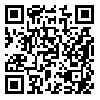Volume 9, Issue 5 (2018)
LRR 2018, 9(5): 241-263 |
Back to browse issues page
Download citation:
BibTeX | RIS | EndNote | Medlars | ProCite | Reference Manager | RefWorks
Send citation to:



BibTeX | RIS | EndNote | Medlars | ProCite | Reference Manager | RefWorks
Send citation to:
Qasemi R A, Moradi M. Structural and Linguistic Study of "A night’s story" by Mehdi Akhavan Sales. LRR 2018; 9 (5) :241-263
URL: http://lrr.modares.ac.ir/article-14-15797-en.html
URL: http://lrr.modares.ac.ir/article-14-15797-en.html
1- Assistant Professor of French Language and Literature- Shahid Beheshti University – Tehran- Iran. , R_ghasemi@sbu.ac.ir
2- Ph.D. Candidate in French Language and Literature- Shahid Beheshti University – Tehran- Iran.
2- Ph.D. Candidate in French Language and Literature- Shahid Beheshti University – Tehran- Iran.
Abstract: (5846 Views)
Around the 1950s and the publication of Jakobson's works on structuralist linguistics, Russian formalists innovated in the field of structural analysis of literary texts. Jakobson’s theory of structuralism has its roots in Husserl and Saussure's discussion; he also separates literary text from the context and the conditions for its creation, and examines it within the text. One of the most prominent manifestations of literary text is poetry; according to Jakobson, poetry language is a language that speaks of a special experimental and semantic construct and its form is inseparable from its meaning. In fact, the method of studying the poetry language is a method of linguistic studies; therefore, in poetry, we study phonological, lexical, syntactic and semantic processes; because poetic language is the language of indirect, mysterious and ambiguous messages. In fact, structuralist critique considers literary texts to be a set of linguistic phenomena that distinguish them from any other text. The processes that make this distinction are recognizable at all levels (phonological, syntactic, and lexical). In this study, we rely on Jakobson's work to examine a poem of Mehdi Akhavan Sales called “A night’s story” . We know that the study of poetry entails mental effort and the search for concepts that the poet, consciously or unconsciously, has included in his literary creation; in the same vein, structuralist analysis helps us to have a careful reading of the text, and to reflect on the form and the format of poem with more delicacy to reach the hidden semantic network of poetry. In fact, the purpose of this study is to answer questions such as how linguistic functions, in the form of the geometric structure of poetry, serve to transfer the concepts better and how does the system of words, behind its superficial structures, include deep concepts appropriate to the space and the main theme of poetry? Structural analysis is a tool that shows that we should not only suffice the initial concept that derives from the text. Since the purpose of the structural analysis is to discover the hidden system and the deep relationship of concepts through the communication of words in a text, this study shows us that in this poem Akhavan has been able to express the concepts of sadness and poverty in a clear and transparent structure. The transparency of the images and the unpredictability of its description are not hidden from the reader's sight. Although this poem is written in the form of a new poem, it has the meter and rhyme, and even these meter and rhyme have added to its richness. Despite the lack of uniformity, the concepts are equally distributed. This poem is also very phonetically rich, and the phonemes emphasize characters and concepts. Finally, it should be acknowledged that Akhavan has been very successful in using words and phrases and while maintaining the beauty of poetry and observing the rules of versification, he has taken advantage of their ability to emphasize the concept of poem and the transfer of implicit concepts. Thus, by examining phonological, syntactic, lexical and semantic processes, we have shown how the system of words has led to the emergence of hidden layers of poem that have been effective in the creation of beauty, and so we have come to discover the semantic network of poem.
Keywords: Structural analysis, Phonological analysis, Lexical analysis, Syntactic analysis, Akhavan Sales
Send email to the article author
| Rights and permissions | |
 |
This work is licensed under a Creative Commons Attribution-NonCommercial 4.0 International License. |







